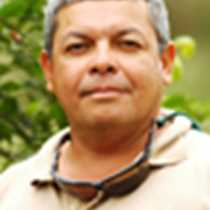Santiago Island
And there is the miracle of life! It was at the moment of landing at Puerto Egas in the Island of Santiago when it all happened. A newly delivered baby sea lion was resting next to his mother in an invitational posture; like saying, “Look at me! I’m cute.” And certainly it was.
Now, right in the dry or garua season here in the Galápagos most of the terrestrial creatures are going into a sort of dormancy. Most plants are without leaves; some others are with leaves but have changed their color turning red. The finches have finished their nesting activities also. However, the sea communities are pretty active and, along with some of the sea birds, the sea lions are beginning to breed. This female resting at the beach was the only one with a baby along the trail.
If we have to anthropomorphize we will say “she is so proud” and she might be. At the least she is very alert protecting her baby. When our guests approached the pair to take pictures, she jumped up and roared menacingly at us. We cautiously moved back, aware that difficult times are ahead for that baby and his Mom, at least during the first year.
Curiously, although we have had many months of drought, during the morning visit to the island of Bartolome, I found a little plant called Chamasysae or spurge, that was in flower! Nature certainly does not follow the information written in books.
And there is the miracle of life! It was at the moment of landing at Puerto Egas in the Island of Santiago when it all happened. A newly delivered baby sea lion was resting next to his mother in an invitational posture; like saying, “Look at me! I’m cute.” And certainly it was.
Now, right in the dry or garua season here in the Galápagos most of the terrestrial creatures are going into a sort of dormancy. Most plants are without leaves; some others are with leaves but have changed their color turning red. The finches have finished their nesting activities also. However, the sea communities are pretty active and, along with some of the sea birds, the sea lions are beginning to breed. This female resting at the beach was the only one with a baby along the trail.
If we have to anthropomorphize we will say “she is so proud” and she might be. At the least she is very alert protecting her baby. When our guests approached the pair to take pictures, she jumped up and roared menacingly at us. We cautiously moved back, aware that difficult times are ahead for that baby and his Mom, at least during the first year.
Curiously, although we have had many months of drought, during the morning visit to the island of Bartolome, I found a little plant called Chamasysae or spurge, that was in flower! Nature certainly does not follow the information written in books.




